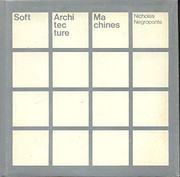

Klik på en miniature for at gå til Google Books
|
Indlæser... Soft Architecture Machinesaf Nicholas Negroponte
Alan Kay's Reading List (102) Der er ingen diskussionstråde på Snak om denne bog. Ingen anmeldelser ingen anmeldelser | tilføj en anmeldelse
This book is an offspring of Negroponte's The Architecture Machine,published by The MIT Press in 1970. As is usually the case where computer systems are involved, the new generation is several orders of magnitude more powerful than even its remarkably mind-extending parent. The last few years have represented a "passing from an idiom to a reality, following (not necessarily consciously) notions set down in The Architecture Machinewith an uncanny precision. The prognostications of hardware enumerated in wanton fantasy have been achieved and even superseded in the actual Architecture Machine of 1972." The general assumption of this new book is that the architect is an unnecessary and even detrimental middleman between individual, continuously changing needs and the continuous incorporation of those needs into the built environment. The book proposes a new kind of architecture without architects, and even without surrogate architects. The first chapter sets forth generally what is involved in learning to understand both the makings of intelligence and the making of architecture. It reveals polarities in attitudes toward thinking about thinking, and it appraises techniques—real and potential—that lead to meaningful thought about the process. A more direct analysis of architectural design activities is presented in the second chapter. Its goal is to achieve a closer coupling between man and machine, and it proposes sidestepping the traditional division of labor in which man and machine are assigned tasks that they are supposed to be respectively better at. Instead, a joint venture model is suggested: man and machine are treated as equal partners, even as candid good friends. The third chapter moves beyond the architect—beyond the need for an outside designer's intervention between our needs and their fulfillment. It asserts that each individual can be the best architect for his own needs and does not require a paternalistic human or mechanical architect to dictate his final decisions. The last chapter—furthest out of all—looks toward a distant future not only beyond the architect but beyond architecture as we know it. Here architecture machines are not simply used as aids in the design of buildings—they serve as buildings in themselves. Man will live in living, intelligent machines or cognitive physical environments that can immediately respond to his needs or wishes or whims. The possibilities are unlimited and a challenge to any imagination. No library descriptions found. |
Current DiscussionsIngen
 Google Books — Indlæser... Google Books — Indlæser...GenrerMelvil Decimal System (DDC)729.028The arts Architecture Design and decoration of structures and accessoriesLC-klassificeringVurderingGennemsnit: Ingen vurdering.Er det dig?Bliv LibraryThing-forfatter. |
||||||||||||||||||||||||||||||||||||||||||||||||||||||||||||||||||||||||||||||||||||||||||||||||||||